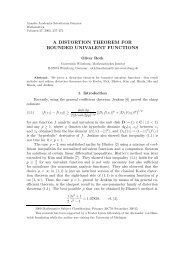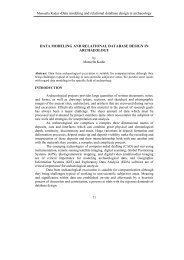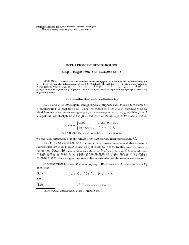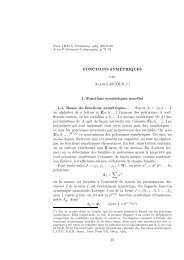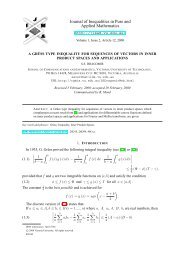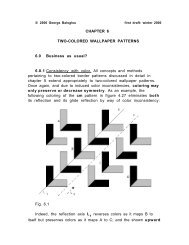SUPERNOMIAL COEFFICIENTS, BAILEY'S LEMMA AND ROGERS ...
SUPERNOMIAL COEFFICIENTS, BAILEY'S LEMMA AND ROGERS ...
SUPERNOMIAL COEFFICIENTS, BAILEY'S LEMMA AND ROGERS ...
Create successful ePaper yourself
Turn your PDF publications into a flip-book with our unique Google optimized e-Paper software.
14 S. O. WARNAAR(with M ∈ Z 3 +) to suggest how (after taking out possible factors) to iteratefurther.Another important problem is to generalize (6.2) to higher levels. Here theobservation is that 1/(q) n−1∞ (divided by q (n−1)/24 ) is the level-1 A (1)n−1 stringfunction. It is thus natural to ask for a generalization of (6.2) involving level-N A n−1 string functions [20]. The simplest such functions admit the followingrepresentationC k (q) = 1 ∑ q 1 2 η(C⊗C−1 )η,(q) n−1∞ (q)ηηfor k ∈ Z n such that |k| = 0. Here η is a vector in the tensor-product spaceZ n−1 ⊗ Z N−1 with entries η (a)j , a = 1, . . . , n − 1, j = 1, . . . , N − 1, C ⊗ C −1denotes the tensor product of the A n−1 Cartan matrix and the inverse A N−1Cartan matrix, and the sum is over η such that∑ n−1i=a k N−1∑i− C −11,jNη(a) j ∈ Z, a = 1, . . . , n − 1.j=1Multiplied by q −(n2−1)N/24(N+n) , C k is the string function Cµ Λ in the representationof Georgiev [16], with Λ = NΛ 0 and µ = ∑ n−1a=1 (k a − k a−1 )¯Λ a (k 0 = k n ). Itwas conjectured in [37] (equation (9.9) with l = λ = σ = 0) that the followingidentity holds.Conjecture 6.3. For n ≥ 2, N ≥ 1 and k ∈ Z n such that |k| = 0,∑q 12N LCL S(L, k) ∑ [ ]q 1 2 η(C⊗C−1 )η µ + η(6.4)ηηL∈Z n−1+= q 12N (k2 1 +···+k2 n ) C k (q).Here the following notation is employed on the left-hand side. The sum overη ∈ Z n−1 ⊗ Z N−1 denotes a sum such thatN−1L aN − ∑C −11,j η(a) j ∈ Z, a = 1, . . . , n − 1.j=1The vector µ is fixed by η through the equation(C ⊗ I)η + (I ⊗ C)µ = CL ⊗ e N−1 ,where I is the identity matrix and e j is the jth standard unit vector. Forv, w ∈ Z p , [ ]v+w∏v = p]i=1 . A proof of conjecture 6.3 for n = 2 has been[ vi +w iv igiven in [36].The simplest application of the previous propositions and conjecture requiresthe A n−1 form of equations (3.3) and (4.1).



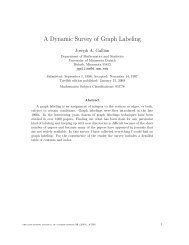


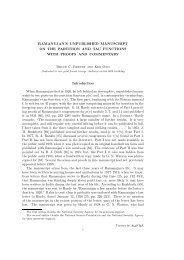
![(.,t ] and [s, .) , where [s,t ] = {s' GT; s ¤ s' ¤ t} , (.,t ] = {s' GT; s' ¤ t} and ...](https://img.yumpu.com/43303393/1/184x260/t-and-s-where-st-s-gt-s-a-s-a-t-t-s-gt-s-a-t-and-.jpg?quality=85)


